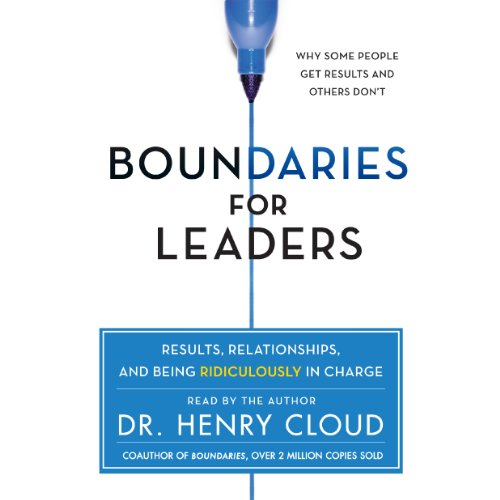Leadership, the ability to set effective boundaries is crucial for both personal well-being and organizational health. In their insightful book, “Boundaries for Leaders,” Dr. Henry Cloud and Dr. John Townsend delve into how leaders can cultivate success by establishing clear limits in their professional environments. This blog explores the key concepts from the book and discusses practical strategies for leaders to implement boundaries that foster a culture of respect, innovation, and productivity.
Understanding the Importance of Boundaries in Leadership
According to Cloud and Townsend, boundaries are essential for leaders because they create clear expectations and establish a framework within which everyone in the organization can operate. Effective boundaries help leaders manage their time, responsibilities, and energy more efficiently, allowing them to focus on guiding their teams toward achieving organizational goals.
Key Principles from “Boundaries for Leaders”
- Define What is Acceptable and What Isn’t: The first step in setting boundaries is to clearly define what behaviors, activities, and responses are acceptable and what are not. This clarity helps prevent misunderstandings and misalignments within the team.
- Focus on Building Character, Not Just Hitting Targets: Cloud and Townsend emphasize that effective leadership is not just about meeting performance metrics; it’s also about building character and integrity within the team. Leaders should set boundaries that encourage personal growth and ethical behavior.
- Cultivate an Environment of Trust and Respect: Boundaries are effective only if they are enforced within an environment of trust and respect. Leaders must lead by example, showing that they respect the boundaries they’ve set and expect the same from their team.
- Communicate Boundaries Clearly and Often: Regular communication about boundaries and their importance can help reinforce their value. Leaders should remind their teams why these boundaries exist and how they protect and benefit everyone in the organization.
- Use Boundaries to Foster Autonomy and Empowerment: Rather than using boundaries to micromanage or control, they should be used to empower employees. Well-defined boundaries can give team members the freedom to explore, innovate, and make decisions within a safe and defined space.

Strategies for Implementing Boundaries in Leadership
Implementing boundaries effectively is a critical component of successful leadership. It requires thoughtful planning, clear communication, and a commitment to uphold these standards consistently. Here’s a deeper look at practical strategies for leaders to establish and maintain boundaries within their organizations.
Regular Training and Discussions
Objective: To ensure all team members understand the boundaries and the rationale behind them, which fosters a respectful and cooperative work environment.
Implementation:
- Scheduled Workshops: Organize regular workshops focusing on key areas such as communication styles, ethical behavior, and conflict resolution. These sessions can help clarify expectations and reinforce the importance of maintaining boundaries.
- Role-playing Scenarios: During training, include role-playing exercises that allow employees to practice responding to situations where boundaries might be tested. This practical approach helps reinforce learning and prepares employees for real-world applications.
- Continual Learning: Make boundary education a part of ongoing professional development. As new situations arise or as the business environment changes, updating training materials will be crucial.
Feedback Mechanisms
Objective: To create a culture where feedback is valued and used to enhance the workplace environment, making boundary adjustments more responsive and dynamic.
Implementation:
- Regular Surveys: Utilize surveys to gather anonymous feedback on how boundaries are working within the team. This can provide insights into areas that may need adjustment.
- Open-Door Policy: Promote an open-door policy where employees feel comfortable discussing boundary-related issues directly with leadership without fear of repercussions.
- Feedback Loops: Establish regular review meetings where feedback on boundaries can be discussed openly. This helps to ensure that the boundaries remain relevant and effective.
Monitor and Adjust
Objective: To maintain boundary effectiveness over time, adapting to changes within the organization and its external environment.
Implementation:
- Regular Reviews: Set a schedule to review the boundaries at regular intervals or after significant organizational changes.
- Adaptability: Be prepared to adjust boundaries in response to new challenges or opportunities. This may involve tightening certain guidelines or relaxing others based on what is most effective.
- Data-Driven Decisions: Use data from performance metrics, employee satisfaction scores, and feedback mechanisms to inform decisions about boundary adjustments.
Enforcement with Empathy
Objective: To handle boundary violations in a way that maintains respect and understanding, fostering an environment of learning rather than punishment.
Implementation:
- Consistent Application: Ensure that all boundary violations are addressed consistently, regardless of who is involved. Inconsistency can lead to perceptions of unfairness and reduce boundary effectiveness.
- Empathetic Approach: When a violation occurs, discuss the situation privately with the involved individual(s). Seek to understand the context and reasons behind the violation, and use the opportunity for coaching and development.
- Restorative Actions: Focus on restorative rather than punitive measures when possible. Encourage solutions that help repair any impacts of the violation and prevent future occurrences.
Personal Boundaries
Objective: To lead by example in maintaining a healthy work-life balance, which encourages employees to respect their own limits and those of others.
Implementation:
- Modeling Behavior: Demonstrate effective personal boundary management by not sending emails late at night, respecting weekends and holidays, and taking scheduled breaks.
- Communication: Be open about your personal boundaries. This transparency can help normalize boundary setting across the organization.
- Support Structures: Implement policies that support personal boundaries for all employees, such as flexible working hours, mental health days, and respecting vacation times.
Conclusion
In “Boundaries for Leaders,” Dr. Henry Cloud and Dr. John Townsend provide a roadmap for how leaders can use boundaries to drive an organization’s success. By setting and managing boundaries effectively, leaders can enhance team performance, improve communication, and promote a healthy work environment. Ultimately, the strength of a leader is often seen in how well they can establish boundaries that propel their teams forward while safeguarding their well-being and the organization’s integrity.

